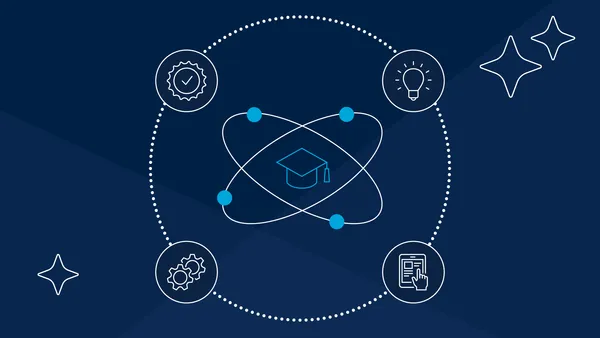In May, Syracuse University’s law school graduated its first class of students earning a Juris Doctor degree through a hybrid program, called JDinteractive, or JDi. The 45 class members were part of almost 200 Syracuse students who received a J.D. this year, according to a university announcement.
The private nonprofit, located in upstate New York, won approval from the American Bar Association in 2018 to offer the three-year hybrid program.
The ABA strictly limits distance education, requiring a waiver for colleges that wish to offer more than one-third of their credits online. To date, the ABA has only approved distance education J.D. programs at about a dozen schools, including Syracuse.
Syracuse lauded the students in the inaugural class, contending that the group is diverse, aligning with the program’s goal of increasing access to legal education. The students come from 25 states, around one-fourth are members of the military or are military-affiliated, and 30% are students of color. Their median age is 35.
We spoke with Shannon Gardner, the law school’s associate dean for online education, to learn more about how the hybrid program has evolved and fared since its inception.
This interview has been edited for clarity and brevity.
HIGHER ED DIVE: What prompted Syracuse to launch the hybrid law program?
SHANNON GARDNER: My role as associate dean for online education started last year, but I have been teaching in the JDi program since it began. I can talk to you about its start, but it's really from the perspective of a faculty member — not so much the dean for the program.
It was a fortuitous occasion because we started a hybrid online program before COVID. It was at a time when getting on Zoom and other online platforms was not part of everyone's day-to-day.
We had been discussing having an online program for quite a while. We realized there is a population out there that really cannot attend traditional residential programs. Certainly, for full-time working professionals in a particular area — like Los Angeles or D.C. — they can attend law school through a part-time evening program, but the geographic availability of those programs is limited.
There is a population out there of folks who already have an established full-time job, who may be in more remote areas, who have personal or family commitments that preclude them attending a full-time residential program. We saw there are people who are really passionate about attending law school, about pursuing their J.D. and really are great candidates for a legal education, but for whom the traditional route just makes it inaccessible.
How does the demographic makeup of the JDi students differ from that of students in the traditional program?
Most of them are employed while they're pursuing their legal education. The median age of our students is higher than our residential students. And certainly we draw from a broader geographic area. While we do have military and military-affiliated students in our residential program, we have a higher percentage in our online hybrid program. And the majority of them are primary caregivers for children or other dependents, so that’s different from most of our residential students.
Were their outcomes, such as graduation and retention rates, different from those in the traditional program?
No — similar outcomes across both populations.
When Syracuse received ABA approval to create its JDi program, it was one of only a handful of programs that was allowed to operate with mostly online coursework. What kind of pressure do you think that put on the institution to prove that this could work?
I don't think it put pressure on the institution. I taught in the program from its inception. I was excited about the opportunity. I was excited to prove that the same quality of legal education could be delivered in an online format.
Many folks realize this is the future of legal education — not that it will replace traditional programs. It is one route to pursue a legal education that is here to stay. I did not see it as pressure, and I think, by all accounts, we have definitely proven that it is and can be a success.
Most of the professors we utilize in our online program also teach in the residential program. So there is overlap in both professors and classes, which I think is really important. Our students who graduated from the JDi program were part of the same graduating class, were ranked along with their residential colleagues. They completed the same requirements as for the residential program.
My big thing is, if we make law school and the study of law more accessible, in turn, that makes the legal profession more accessible. All of those things signal success — not just for legal education — but really for the legal profession as well.
The legal field relies on teaching through the Socratic method. How is the hybrid program able to do that?
For semester-long classes, our program utilizes a 50/50 model. Half of their classes will be synchronous, live lectures. You meet on Zoom for a live class every week for half of your class time. The other half is asynchronous, self-paced classes — lectures that have been prerecorded by the professor.
We typically do not enroll more than 34 or 35 students per section. So at all times the professor can see everyone on the screen. Students are not permitted to turn off their video, so they need to appear in class. And the professors utilize the same protocols from their residential classes. There is random cold calling. The professor asks follow-up questions. The Socratic method is employed.
In the asynchronous classes — the prerecorded lectures — professors utilize a number of interactive features. Students answer a hypothetical question and then before they proceed to new material, they view a simulated dialogue about that. It requires students to think critically about the material, which is the ultimate point of why we utilize the Socratic method.
The pandemic was an unexpected event for the inaugural class. Did the hybrid program have to change any elements in response?
It was a benefit to our residential programs to have the online program running. We all had to shift online. If you had to do that and no one at your particular institution had done it before, that would be a much harder move than it was for us. Our online program was able to give training and support.
There were also benefits to our online programs. Things that we had never conceived could be offered in an online program we, through necessity, did online for the residential program, and then that opened up more opportunities for our online students.
For example, we had not conceived that clinics might be part of the online program. We have a number of clinics at the College of Law — a veterans' clinic, a criminal defense clinic, a low-income taxpayers clinic.
The traditional model of the clinic is you go to the offices at the law school and you meet with clients and you are supervised by a professor. Maybe you go make court appearances or things like that.
During the pandemic, those clinics moved online. While not all components of clinics are amenable to the online modality, we realized clients can meet over Zoom. Briefs or documents can be prepared by students wherever they are. They can be supervised by a professor during live meetings over Zoom. Some of our clinic offerings are fully transferable to an online form.





















